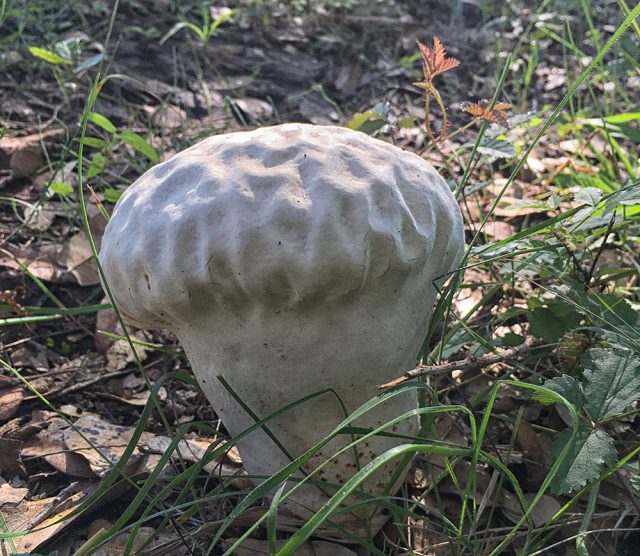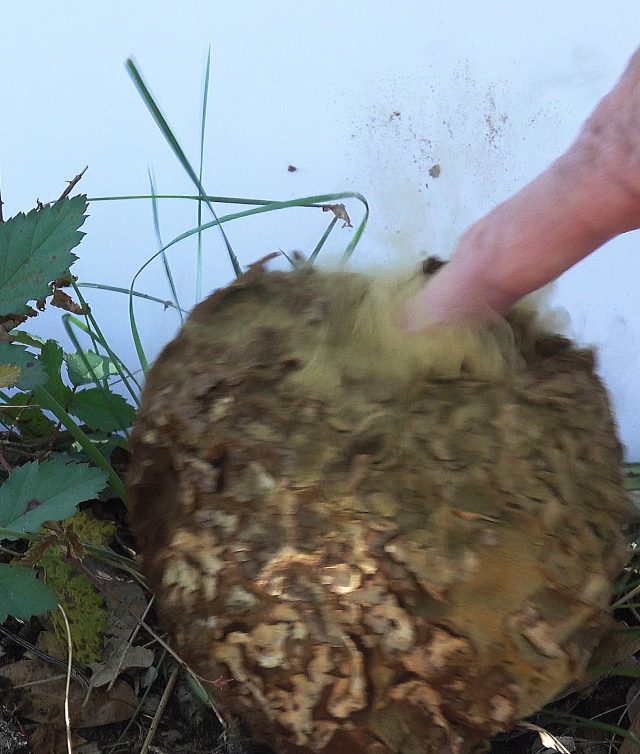
From a distance, this pale white puffball looked like a human skull lying in the shady leaf litter. It is a species of Calvatia mushroom and is related to Calvatia gigantea, the Giant Puffball. “Calvatia” refers to its skull-like appearance. Karen Benson photo.
Even from a distance of a100 yards, the bone-white orb captured my attention. It was rounded, about the size of a human head, and it almost glowed in the shadow of the live oak. I drove closer with some trepidation. I hoped I wasn’t about to discover a body on my farm.
However, as I got closer, I noticed it was smaller than I first thought. It was more like softball size. The surface of the orb was convoluted and dimpled; rather like a cross between a brain and a golf ball. Although it looked quite alien in the leaf litter, I figured it had to be some kind of mushroom. I leaned in and touched the pure white globe. It felt leathery, but soft. The surface gave slightly as I pushed on but it then popped back to its original shape. It reminded me of a stale marshmallow.
This had to be a puffball, a kind of mushroom, but it was the biggest one I had ever seen. I had read about Giant Puffballs, some as big as soccer balls! Could this be a Giant Puffball, perhaps one on the small side? Did they even occur in Texas?
I checked the Internet and indeed, my mushroom appeared to be a Giant Puffball. Wikipedia says they are “commonly found in meadows, fields, and deciduous forests usually in late summer and autumn…and they occur in temperate zones throughout the world.” Is South Texas a “temperate zone” I wondered? Probably not. Still, my puffball looked a lot like the photos of some Giant Puffballs found in Texas.
Typically, the Giant Puffball (Calvatia gigantea) is smooth on the outside, not convoluted. As I scrolled through pictures of mushrooms found in Lick Creek Park, College Station, Texas, I finally found one that was convoluted and dimpled. The photo was taken on 7 October 2013 and it was identified as Calvatia species. Maybe it was not a “giant” puffball but it was closely related!
As I read more about my mystery mushroom, I discovered that puffballs are edible. Some sources said they are not just edible but quite tasty! But, you have to harvest them while they are still pure white inside. The only way to know that is to cut the puffball in half…if it is white and cakey then it is good to eat. If the inside is the least bit brown or purple inside, then it is past its prime; the spores are forming. At that stage, you do not want to eat it. It doesn’t taste as good, and it can make you sick. Puffballs are not poisonous, but an old mushroom is like an over-ripe tomato: not worth eating.
The favored way of cooking a Giant Puffball is to slice it into half-inch slices and saute them in butter and garlic. Because one puffball is more than a meal’s worth of food, the websites suggest you save half of the mushroom for breakfast. Dip the slices in egg and milk and cook them up like French toast! Yum!

Approximately ten days after I first noticed the puffball, it had matured into a spore sac containing trillions of spores. Gentle pressure on the puffball produced a cloud of yellow-brown “smoke.” The smoke is actually a cloud of microscopic spores floating away to new homes in rotting logs. Robert Benson photo.
However, I declined to sacrifice my puffball. Since it was the only one I had ever found on my farm, I wanted it to reproduce and make more puffballs for future consumption. I left it to ripen and produce spores.
It began to darken within a few days. After about a week, the brown surface had small fissures in it. When I poked it, a cloud of brownish-yellow “smoke” came out. This smoke was actually microscopic spores being released. Go spores, go! Fall on some dead wood and sprout. Grow your threadlike hyphae throughout the rotting wood and decompose it. It may take years, but after the mycelium (the collective mass of hyphae) has digested the nutrients out of the old wood, it will reproduce. It will send up a “fruiting body”—the structure we call a mushroom or a puffball. More spores will eventually form inside it.
You can be sure I will be waiting for this future fruiting body: A Giant Puffball with a luscious white interior begging to be sautéed…or made into French toast!
